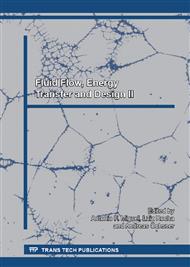[1]
S.A. Hambric, T.M. Mulcahy, V.N. Shah, T. Scarbrough and C. Wu, Flow-Induced Vibration Effects on Nuclear Power Plant Components due to Main Steam Line Valve Singing, Proceedings of the Ninth NRC/ASME Symposium on Valves, Pumps and In-service Testing, vol. 6, pp. 3B: 49- 3B: 69, (2006).
Google Scholar
[2]
G. DeBoo, K. Ramsden, R. Gesior, B. Strub, Identification of Quad Cities Main Steam Line Acoustic Source and Vibration Reduction, Proceedings of the Pressure Vessels and Piping Conference, vol. 4, pp.485-491, (2007).
DOI: 10.1115/pvp2007-26658
Google Scholar
[3]
R. Morita, S. Takahashi, K. Okuyama, F. Inada, Y. Ogawa and K. Yoshikawa, Evaluation of Acoustic and Flow Induced Vibration of the BWR Main Steam Lines and Dryer, Journal of Nuclear Science and Technology, 48: 5, pp.759-776, (2012).
DOI: 10.1080/18811248.2011.9711759
Google Scholar
[4]
K. Okuyama, A. Tamura, S. Takahashi, M. Ohtsuka and M. Tsubaki, Flow-Induced Acoustic Resonance at the Mouth of One or Two Side Branches, The 8th International Topical Meeting on Nuclear Thermal-Hydraulics, Operation and Safety, vol. 249, pp.154-158, (2012).
DOI: 10.1016/j.nucengdes.2011.07.036
Google Scholar
[5]
S. Ziada, P. Lafon, Flow-Exited Acoustic Resonance Excitation Mechanism, Design Guidelines, and Counters Measures, Applied Mechanics Reviews, vol. 66, pp.1-22, (2014).
DOI: 10.1115/1.4025788
Google Scholar
[6]
J. E. Ffowcs Williams and D. L. Hawkings, Sound Generation by Turbulence and Surfaces in Arbitrary Motion, Proceedings of Royal Society, vol. 264, no. 1151, pp.321-342, (1969).
DOI: 10.1098/rsta.1969.0031
Google Scholar
[7]
U.S. Nuclear Regulatory Commission, Regulatory Guide1. 20, Comprehensive Vibration Assessment Program for Reactor Internals during Preoperational and Initial Startup Testing, Revision N° 3, March (2007).
Google Scholar
[8]
Fluent User Guide, Chapter 21. Predicting Aerodynamically Generated Noise, pp.1-28, (2008).
Google Scholar
[9]
W. P. Jones, B. E. Launder, The Prediction of Laminarization with a Two-Equation Model of Turbulence, J. of Heat and Mass Transfer, Vol. 15, pp.301-308, (1972).
DOI: 10.1016/0017-9310(72)90076-2
Google Scholar
[10]
L. Xiong, Y. Lin, S. Li, k-e Turbulent Model and its Application to the FLUENT, Industrial Heating, vol. 36, no. 4, pp.13-15, (2007).
Google Scholar
[11]
C. Wagner, T. Huttl, P. Sagaut, Large-Eddy Simulation for Acoustics, Cambridge University Press (2007).
Google Scholar
[12]
M. J. Lighthill, On Sound Generated Aerodynamically: I. General Theory, Proceedings of the Royal Society, vol. 211, pp.564-587, (1952).
Google Scholar
[13]
M. J. Lighthill, On Sound Generated Aerodynamically. II, Turbulence as a Source of Sound, Proceedings of the Royal Society of London. Series A, Mathematical and Physical Sciences, Vol. 222, pp.1-32, (1954).
DOI: 10.1098/rspa.1954.0049
Google Scholar
[14]
S. Ziada, S, Shine, Strouhal Numbers of Flow-Exited Acoustic Resonance of Closed Side Branches, Journal of Fluids and Structures, vol. 13, pp.127-142, (1999).
DOI: 10.1006/jfls.1998.0189
Google Scholar
[15]
L. H. Hernández-Gómez, G. Urriolagoitia-Calderón, G. Urriolagoitia-Sosa, J. M. Sandoval-Pineda, E. A. Merchán-Cruz, J. F. Guardado-García, Assessment of the structural integrity of cracked cylindrical geometries applying the EVTUBAG program, Revista Técnica de Ingeniería de la Universidad de Zulia, Vol. 32, pp.190-199, (2009).
DOI: 10.1088/1742-6596/181/1/012061
Google Scholar
[16]
N. Moreno, L. H. Hernández, P. Ruiz, G. M. Urriolagoitia, J. A. Beltrán, G. Urriolagoitia, E. Flores, A. Ocampo and B. Romero, Evaluation of the Structural Integrity of the Jet Pumps of a Boiling Water Reactor under Hydrodynamic Loading, Defect and Diffusion Forum, Vol. 348, pp.261-270, (2014).
DOI: 10.4028/www.scientific.net/ddf.348.261
Google Scholar


